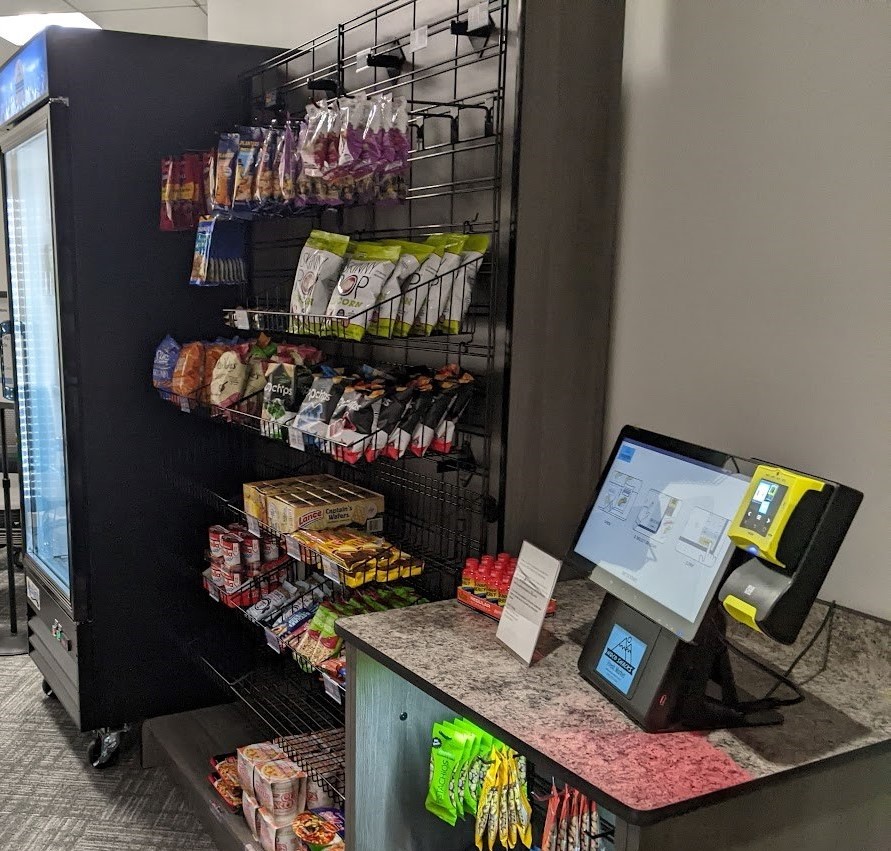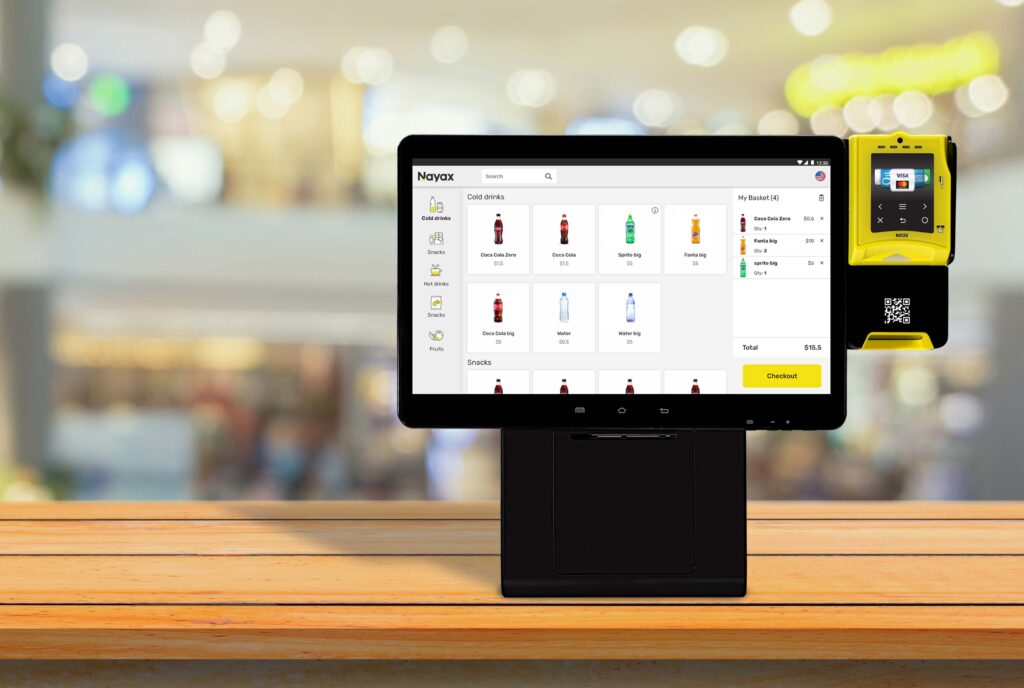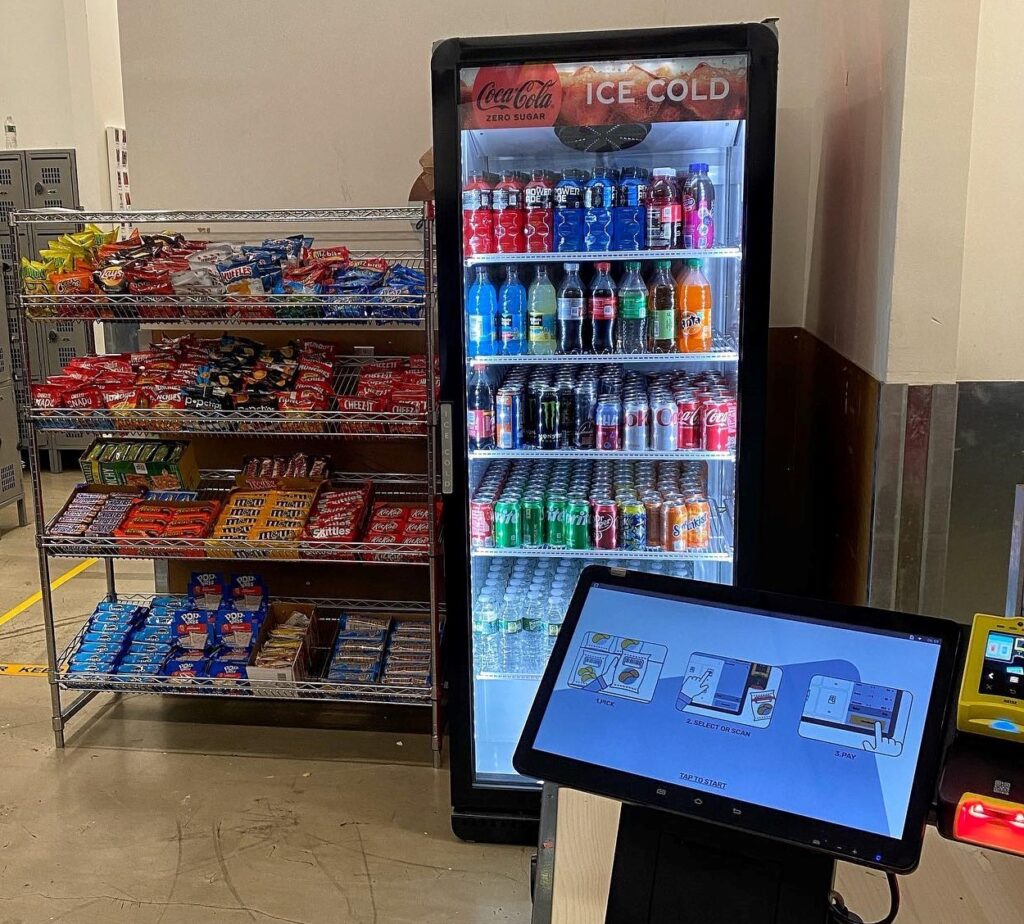Why a Micro Market Vending Business?
Self-service checkout sales grew by 20% in 2022. This is not a coincidence, but a combination of demand due to changing consumer behavior during and after the pandemic, and operators understanding the benefits micro markets can offer that vending machines cannot. First off, micro markets generate 5-6 times the revenue that vending locations do, according to industry revenue figures published by NAMA in the 2020 industry census report. This huge boost in revenue is due to several factors:
Sell Any Product
Operators can sell all kinds of products of all sizes. They are not limited by vending machine shelving that can only fit specific products, and don’t have to worry about buying different shelves for their vending machines in order to provide consumers with the products they want.
Sell More Expensive Products
Because you aren’t limited by space, you can sell any product you want, including more valuable and expensive products such as salads and sandwiches.
Consumer Buy More Products
Consumers buy more products because they can simply grab them, pay, and go. They won’t waste time selecting products at a vending machine or paying for each of them with more than one transaction. Placing tempting items at checkout can also help you grow your revenue, as consumers may pick up these extra items on an impulse and purchase them as well.
Fewer Technical Errors
With a micro market, you won’t need to worry about items getting stuck or not being distributed to the customer.
No Refunds
Compared to vending machine operators, micro market operators don’t have to deal with nearly as many refunds. Since consumers can grab or choose their products on their own, they are very unlikely to pick an item that is past its best buy date, and as mentioned above, they are very unlikely to encounter a technical error.
Loyalty Programs
Because micro markets are mostly located in closed-loop environments such as the workplace, you can work with Human Resources departments, for examples, to develop prepaid cards for employees that they can use at your micro markets, making their purchasing experience more convenient. You can also create discounts, happy hour promotions, and top up bonuses to further incentivize them to return and spend more.
So, how do you build a micro market business? For vending operators, it’s easier than you may think. Keep reading to find out how.
Building Your Micro Market Business Plan
The first step you need to take is to create a business plan for your micro market. This includes defining how much you want to invest and at which locations. When deciding where to locate your micro market, you may want to consider locations at which you already have vending machines. Already knowing the location, its managers, and its consumers can help you make a more educated decision about where to open your micro market. As we mentioned above, closed-loop environments such as offices and factories are some of the most popular locations for micro markets, as they are generally closed to the public and have higher security and trust.
When it comes to investment, you will need to consider several things. These will vary depending on the size of your business, but your infrastructure costs will include: a warehouse to stock your goods before selling them, technological solutions to help you manage your business and inventory, and drivers and technicians that can visit your location to restock products and fix and technical issues. On top of these costs, you will need to think about other starting costs such as a self-checkout kiosk, shelving, refrigerators, and security cameras. Though this sounds like a lot at the beginning, most of these are one-time costs. Consider taking out a loan for these costs to help you get started.
Startup costs for a micro market may be in the $10,000 range for two fridges and two shelves, although you can buy more basic or wooden shelves in order to keep your costs down. You will also need to add another $3,000-$6,000 for a self-checkout kiosk and security cameras. Buying a new vending machine could cost you anywhere from $3,000-$10,000. When you think about it, a $16,000 investment for the chance to increase your revenue by 65-70% is worthwhile.
Pro tip: When you consider which of your vending locations would be most suitable to convert into a micro market, choose those with the highest potential for revenue and the lowest risk. Think of locations with long working hours, and also consider that you’ll have to visit this location fairly often to restock, maybe even every day, so make sure that It’s on one of your main restocking routes so that it can conveniently fit into your driving schedule.
Ask us about our micro market solutions
What Do You Want to Offer Customers at Your Micro Market?
Based on the location you choose for your micro market, you can start planning what you’d like to offer your customers. If you’re opening a micro market at the same location you already operate vending machines, use your management software to look at and analyze the data from these machines. Do healthy snacks sell more than regular ones? Do you sell higher-priced items such as sandwiches? If so, how well do those sell? Do you want to sell other fresh food such as salads?
When you ask yourself these questions, think about if you can support them logistically. The products you offer in each of your micro markets may vary. If you plan on opening more than one micro market location, it’s best to sell the same products at every location. This will help streamline your stock and inventory management.
Once you’ve decided which products you want to offer and how to store and stock them, you’ll need to find a supplier. You may be able to use the same supplier you use for your vending machines, at least for most of the items. And while you’re talking to them, why not ask if they know other suppliers that may be able to provide you with the rest of the items you need?
Pro tip: When you think about what you want to stock, don’t stop at products. You’ll want to include categories such as sandwiches, salads, healthy snacks, or fruits and vegetables. You’ll want to offer the right selection of products within each category and understand which ones sell the best. Knowing which products you want to offer will help you understand how many refrigerators you need.
Micro Market Equipment: What You Need
Self-Checkout Kiosk
One of the most important items you need to purchase for your micro market is a self-checkout kiosk. Since your micro market will be unmanned, make sure you choose a self-checkout kiosk with an easy-to-use interface so that customers will know what to do. Ease of use will provide them with a good purchasing experience and will encourage them to return.
Pro tip: Consider the special needs your locations may have. Some micro market point of sales also offer digital receipts, detailed product description fields, multiple languages, and the ability to promote new products on screen.
Micro Market Management Software
When you choose your self-checkout kiosk, you’ll want to make sure that it can integrate with micro market management software. Management software will help you collect data, manage your inventory, track sales, and more. With Nayax’s mobile management app, MoMa 2.0, you can remotely monitor your micro market from the palm of your hand, and customize your alerts to keep track of your business no matter where you are.
Pro tip: You’ll want an app that’s easy to use and to update products and stocks. After all, you and your team will need to be able to update inventory while on the road.
Cashless Payment Acceptance
When you open a micro market business, it is imperative that you accept cashless payments. Very few micro market transactions are cash, and accepting cashless payments will help decrease the risk of theft and help secure your business. Beyond accepting traditional cashless payments such as credit and debit cards and NFC mobile payments, you’ll want to make sure you also accept prepaid cards, especially if your micro market is located in a closed-loop environment such as an office, hospital, or university. This will help provide your consumers with an easy and exclusive way to pay, and you can also develop loyalty programs in these environments in order to further incentivize them.
Pro tip: If your micro market is located at a workplace, your customers may want to position it it as employee welfare. In this case, employees will be able to they pay with their employee cards. Employers can add a monthly sum to these cards, and employees can recharge them. As an operator, you can manage prepaid cards through the management suite you use. This is a great way to have happy consumers and steady revenue growth.
Lighting and Signage
Since micro markets are still a fairly new concept, you want to make sure your consumers know where they need to pay. Having a large “Checkout” sign at your self-checkout kiosk will help make the purchasing experience clearer and smoother.
Pro tip: Some self-checkout kiosks allow you to use their screen for advertising, so you can also use the kiosk itself to let consumers know where to check out.
Security Cameras
Micro markets are built for high trust environments. However, having security cameras adds an extra level of security and helps you prevent any theft and manage shrinkage. Adding more signs in order to enhance security can also help deter theft, such as a sign that says that the micro market is monitored by security camera or simply an image of eyes.
Pro tip: The location you place your micro market at may already have security cameras installed. You may want to use them and further reduce your costs, giving the employer a sense of shared responsibility in the case of theft.
Fixtures and Shelving
Fixtures and shelving help you store and display your products. However, they are also an opportunity for branding. What kind of feeling do you want to give your customers? Which items do you want to stand out?
Pro tip: Think about your target audience. You may not use the same fixtures at a bank as you would at a factory.
Micro Markets: The Consumer Experience
At the end of the day, micro market and vending businesses are service-oriented, and heavily depend on you relationship with your customers. At micro markets, visiting your location regularly is important so that you can make sure that you keep items in stock and make sure the items are always fresh. In order to save time while doing this, a good inventory management tool is essential. This will help you understand what items need to be restocked before you visit the location, so that you can arrive with exactly what you need.
And when you visit your location, make sure you pay attention to what your micro market looks like and how your customers are experiencing it. Talking to them directly is also a great help, it’ll help you understand what they like about shopping there and what you can improve.
Managing Your Micro Market Business with the Most Efficient Workflows
When it comes to managing your micro market business, it’s good to start with a vision in mind. With concerns such as stock, inventory, product freshness, sales, device status, and more, choosing the right management platform is critical to your business’ success. If you manage micro markets at several locations, you’ll also need to take route management into consideration, and try to minimize your drivers’ time on the road to make your business more efficient and profitable.
If you’re used to managing your business with a pen and paper, now might be the time to consider a cloud-based management system which will help you automate many of your processes and save time. A micro market business requires you to monitor your KPIs (key point indicators) daily, so having access to information in real time will help you avoid manual calculations and make the process much easier.
Ask us about our management tools
Preventing Theft at Your Micro Market
And last but not least, you’ll want to consider having an anti-theft strategy in place. As mentioned above, you’ll want to place your micro market business in a high trust environment. However, it can’t hurt to take some more measures to ensure that your micro market business is extra secure. Here are a few things that you can do:
- Use remote monitoring to make sure that inventory levels are where they should be.
- Take potential theft into account when you price your items.
- Use a sign to indicate where the self-checkout kiosk is located so that customers know where and how to pay.
- Install security cameras.
Scaling Your Micro Market Business
Once you’ve got the hang of running a micro market business after a few months, you’ll be able to easily scale and grow your business. The concept will remain the same, but you will have to adjust some of your workflows, routes, and product management based on the amount of consumers and products you choose to sell. With Nayax’s end-to-end solution, you’ll have everything you need to grow and increase your revenue. Want to get started with micro markets? Contact us today.





